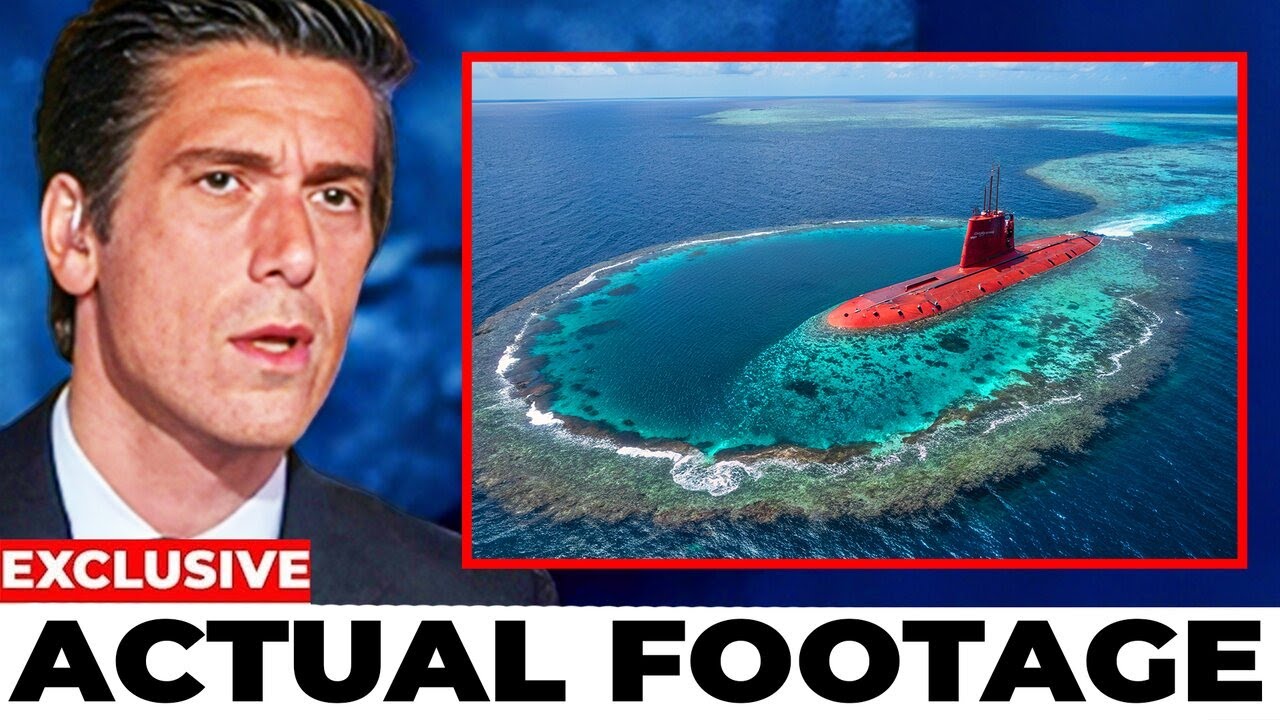What lies hidden in the abyss of the Great Blue Hole? 🌊😱
In 2018, a daring team of explorers, including Richard Branson and Fabien Cousteau, plunged into Belize’s iconic underwater sinkhole in a submarine. What they discovered 400 feet below the surface—a haunting mix of ancient secrets, eerie relics, and a silent graveyard—left the world stunned. Could this mysterious void hold clues to Earth’s ancient past… or something even more unsettling?
Dive into the chilling discoveries yourself! Click the link to uncover the full story:

The Great Blue Hole, a colossal marine sinkhole off the coast of Belize, has long captivated adventurers, scientists, and divers with its enigmatic depths. Measuring 1,043 feet across and plunging 407 feet into the ocean floor, this UNESCO World Heritage Site, part of the Belize Barrier Reef Reserve System, is the world’s largest underwater sinkhole. Made famous by Jacques Cousteau in 1971, who declared it one of the top diving sites globally, the Great Blue Hole has been a magnet for exploration. In December 2018, a high-profile expedition led by Aquatica Submarines, featuring billionaire Richard Branson, oceanographer Fabien Cousteau, and chief pilot Erika Bergman, ventured to its depths using advanced submersibles. Their mission: to create the first 3D map of the sinkhole’s interior and unravel its geological and biological mysteries. What they found—a mix of ancient stalactites, a toxic hydrogen sulfide layer, human remains, and cryptic tracks—stunned the global community and offered profound insights into Earth’s history and human exploration. This article explores the expedition’s groundbreaking discoveries, their implications, and the enduring allure of this underwater enigma.
The Great Blue Hole: A Geological Marvel
Located 62 miles off Belize’s coast within the Lighthouse Reef Atoll, the Great Blue Hole is a near-perfect circular depression formed during the Quaternary glaciation, when sea levels were significantly lower. Analysis of its massive stalactites, some 40 feet long and two feet wide, indicates formation phases at 153,000, 66,000, 60,000, and 15,000 years ago, when it was a dry limestone cave. As glaciers melted and sea levels rose, the cave flooded, and its roof collapsed, creating the sinkhole we see today. Jacques Cousteau’s 1971 expedition aboard the Calypso brought global attention to its sheer walls, vibrant marine life, and submerged geological features, cementing its status as a diver’s paradise.
Despite its fame, the Great Blue Hole’s deepest reaches remained largely uncharted until 2018. While scuba divers explored its upper regions, teeming with Caribbean reef sharks and giant groupers, the lower depths—beyond 300 feet—were a dark, oxygen-starved zone inaccessible to traditional diving. The 2018 expedition aimed to penetrate this abyss using two submersibles, the Stingray 500 and Idabel, equipped with high-resolution sonar to map the sinkhole’s interior. Over 22 dives from November 27 to December 13, 2018, the team sought to uncover the geological and ecological secrets hidden beneath the surface.
The Expedition: Piercing the Hydrogen Sulfide Veil
The descent into the Great Blue Hole revealed a dramatic shift in conditions. At approximately 290 feet, the team encountered a thick layer of hydrogen sulfide (H2S), a toxic, dissolved gas that forms a barrier, blocking light and oxygen. Erika Bergman, the expedition’s chief pilot, described the transition as plunging into “complete blackness,” where the vibrant Caribbean sunlight vanished, leaving an anoxic, lifeless void. This H2S layer, spanning the entire sinkhole, preserves anything that falls below it by preventing decomposition, creating a natural time capsule.
Using advanced sonar, the team produced the first 3D map of the sinkhole’s interior, revealing intricate features invisible to the naked eye. At depths of 130 to 160 feet, they documented stalactite caverns formed when the cave was dry, offering clues to ancient sea level changes. These formations, some tilted due to tectonic shifts, confirmed that sea level rise occurred in dramatic bursts rather than gradually, reshaping our understanding of Earth’s climatic history. At 290 feet, a calcium carbonate layer marked a former coral reef from a time when the area was shallow water, further evidencing geological shifts.
Haunting Discoveries: Relics and Remains
Beyond geological insights, the expedition uncovered sobering signs of human presence. At the bottom, the team found a two-liter Coke bottle, a GoPro camera with intact footage, and hundreds of conch shells—remnants of sea life that fell into the hole and suffocated in the oxygenless depths. Most poignantly, they discovered the remains of two divers, believed to be among three reported missing in the sinkhole’s history. Out of respect, the team, in consultation with Belizean authorities, left the bodies undisturbed, describing them as “at peace” in the dark, preserved environment. The divers’ equipment, including old scientific gear and marks suggesting attempts to escape, painted a tragic picture of their final moments.
The expedition also noted mysterious “crisscrossing circles” at the bottom, tracks with no clear origin, which Bergman described as “open to interpretation.” These enigmatic markings sparked speculation—could they be natural sediment patterns, human artifacts, or evidence of unknown phenomena? The team’s findings, documented in a minidocumentary by Aquatica Submarines, highlighted the sinkhole’s dual nature as both a geological treasure and a silent graveyard.
Scientific and Cultural Significance
The 2018 expedition provided unprecedented data for marine science. The 3D map, constructed over two weeks of monitoring post-dive, offered a digital blueprint of the sinkhole’s structure, aiding researchers in studying karst formations and sea level changes. The stalactites and terraces revealed how the Great Blue Hole formed in stages, supporting theories of abrupt climatic shifts during the last Ice Age. Bergman suggested the sinkhole might connect to a larger underwater cave system, as an enormous cavern near the bottom hinted at uncollapsed structures elsewhere in the reef. This hypothesis has spurred interest in future expeditions to explore potential links with other blue holes, like the nearby Green Banana, which extends to 425 feet.
Culturally, the Great Blue Hole remains a symbol of adventure and peril. Its reputation, amplified by Cousteau’s legacy, draws thousands of divers annually, despite its dangers. The presence of human remains underscores the risks, particularly for recreational divers venturing beyond safe depths. Nitrogen narcosis, which impairs judgment at depths approaching 130 feet, poses a significant threat, as does the sinkhole’s sheer scale, which can disorient divers. The expedition’s findings, broadcast live on the Discovery Channel, captivated global audiences, reinforcing the sinkhole’s mystique.
Environmental and Ethical Reflections
The expedition also highlighted environmental concerns. The discovery of plastic debris, like the Coke bottle, underscored ocean pollution’s reach, even in remote depths. The anoxic environment below the H2S layer preserves such debris, creating a stark reminder of humanity’s impact. The team adhered to a “leave no trace” ethos, taking only pictures and leaving the site undisturbed. Ethically, the decision to leave the divers’ remains in place sparked debate. While respectful, it raised questions about recovery versus preservation, reflecting broader discussions in marine archaeology about handling human remains in underwater sites.
Future Exploration and Legacy
The 2018 expedition marked a turning point in understanding the Great Blue Hole, but many questions remain. The unidentified tracks and potential cave connections invite further study, potentially with advanced robotics or submersibles capable of deeper exploration. The National Oceanic and Atmospheric Administration (NOAA) has since explored similar blue holes, like the Amberjack Hole off Florida, to investigate microbial life and groundwater connections, building on the Thresher’s legacy.
The Great Blue Hole continues to captivate, blending beauty with danger. Its depths hold clues to Earth’s past and humanity’s limits, as evidenced by the lost divers and preserved relics. The 2018 expedition, through its meticulous mapping and poignant discoveries, not only illuminated the sinkhole’s secrets but also honored the sacrifices of those who ventured too far. As Bergman noted, exploration changes perspectives, and the Great Blue Hole remains a testament to the human drive to uncover the unknown, even at great risk.
Conclusion
The 2018 Great Blue Hole expedition revealed a world frozen in time—stalactites from ancient caves, a toxic barrier preserving relics, and the somber resting place of lost divers. These findings, captured through advanced technology and shared globally, deepened our understanding of Earth’s geological history while highlighting the ocean’s unforgiving nature. The Great Blue Hole stands as a monument to exploration’s triumphs and tragedies, urging future adventurers to tread carefully in its depths.





